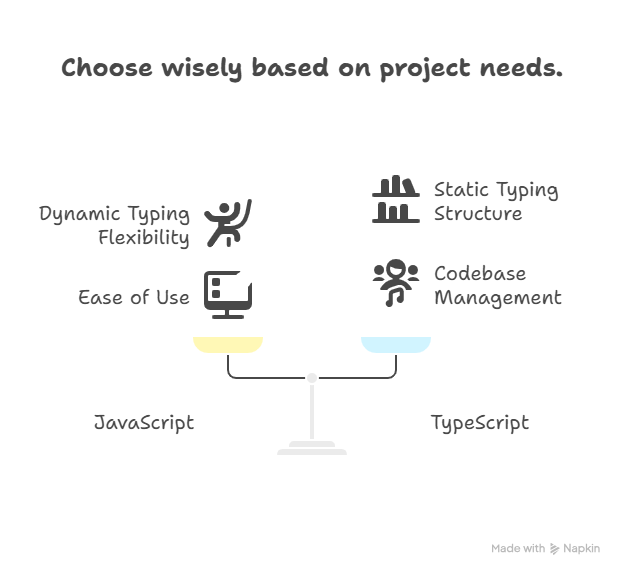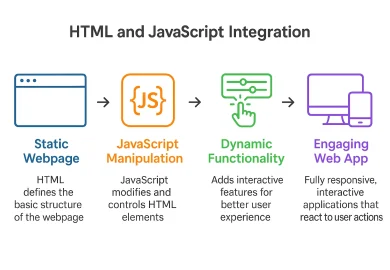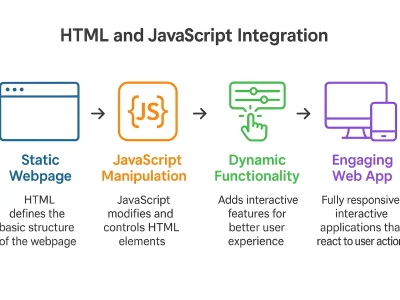Introduction
JavaScript vs TypeScript is one of the most debated comparisons in modern web development. While JavaScript has been the cornerstone of interactive web applications since 1995, TypeScript — introduced by Microsoft in 2012 — has quickly gained traction, especially for building scalable and maintainable codebases.
In today’s development landscape (2025), choosing between these two languages has become more critical than ever. With the rise of complex applications, microservices, and collaborative team development, understanding their differences is essential for making the right technology choice.
In this guide, you’ll learn:
- Salient differences between JavaScript and TypeScript
- Real-World Examples and Code Snippets
- Pros and cons of each language
- Which one to go with for your next project
Let’s explore the current trends and make the right decision for your development journey.
What is JavaScript?
JavaScript is a dynamic, prototype-based, object-oriented, high-level, and interpreted programming language, known for its Speed, unrivalled flexibility, and excellent efficiency. Created by Brendan Eich in 1995 at Netscape Communications Corporation. It used to be named LiveScript. However, the name was changed to JavaScript so that it could leverage Java’s support to gain popularity.
Despite the name, JavaScript has nothing to do with Java. It eventually became the de facto scripting language for web browsers, and it could be used to add dynamic behavior to webpages; for example, to perform real-time validation of form input, update content, and animate graphics.
By the end of the 1990s, all major browsers had a compatible JavaScript engine, and in 1997, the language was standardized by ECMA International with the first edition of the standard published as ECMA-262.
JavaScript, however, has several significant new editions since the:
ES5 (2009): Cleaned up existing syntax, and added JSON support
ES6 / ECMAScript 2015 (2015): A significant release, containing additions such as classes, modules, arrow functions, promises, and let/const.
Spiffy JavaScript (ES6+): A fresh language each year can’t be beat, with support for things like async/await & optional chaining 🙂
Today, JavaScript is not confined to the browsers. The rise of environments like Node. js, JavaScript is now a fully-fledged language for writing the frontend and backend, mobile applications, desktop applications, and even IoT devices.
Key Features
- Dynamic typing
- Prototype-based object orientation
- Event-driven and asynchronous programming (via callbacks, promises, async/await)
- Runs directly in the browser and environments like Node.js
JavaScript in Web Development
JavaScript now powers:
- Web applications (React, Vue, Angular)
- Mobile apps (React Native)
- Server-side development (Node.js)
- Progressive Web Apps (PWAs)
Ecosystem and Market Trends
- Frameworks: React, Angular, Vue, Svelte
- Libraries: jQuery, Lodash, D3.js
- Runtime: Node.js
- Market Stats: Over 98% of websites use JavaScript
- Jobs: Widely required for frontend and backend roles
What is TypeScript?
Microsoft designed TypeScript, which was introduced in 2012. It is a typed superset of JavaScript, meaning that any valid JavaScript code is also valid in TypeScript.
Key Features
- Static typing via type annotations
- Advanced type system: interfaces, enums, generics
- Compile-time error detection
- Modern ES6+ support with backwards compatibility
Why Enterprises Love It
For large codebases, TypeScript brings stability and organization to the chaos. And it can be tightly integrated with IDEs such as VS Code, with which it offers powerful enhancements, including autocomplete, refactoring, and error-solving.
Compilation Process
TypeScript is compiled to JavaScript by the TypeScript compiler (tsc) so that it can run in a browser.
Key Differences Between TypeScript and JavaScript
Here’s a detailed comparison of JavaScript and TypeScript based on their core features:
| Feature | JavaScript | TypeScript |
| Typing | JavaScript uses dynamic typing, meaning variables can hold any type of value, and their type can change at runtime. This makes it flexible but also error-prone. | TypeScript introduces static typing, where you explicitly define variable types using annotations. This helps catch type-related errors during development. |
| Compilation | JavaScript is interpreted by the browser or runtime environment, meaning it runs directly without a separate compilation step. | TypeScript must be compiled into JavaScript using the TypeScript compiler (tsc) before it can be run in a browser or Node.js. |
| Error Detection | Errors in JavaScript are primarily detected at runtime, which can lead to bugs that only become apparent after deployment. | TypeScript catches many errors at compile-time, helping developers fix issues before running the code. |
| Learning Curve | JavaScript has a gentler learning curve and is easier for beginners to pick up quickly, especially for small projects. | TypeScript has a slightly steeper learning curve due to type annotations, interfaces, and compiler setup, but it pays off in large projects. |
| File Extension | JavaScript files use the .js extension. | TypeScript files use the .ts extension, which is then compiled into .js before execution. |
Code Example: JavaScript vs TypeScript
Let’s explore a basic function example to understand how TypeScript enhances code reliability compared to JavaScript.
JavaScript
javascript function greet(name) { return "Hello, " + name; } console.log(greet("Alice")); // Output: Hello, Alice console.log(greet(123)); // Output: Hello, 123 — no error, but unintended behaviour
In JavaScript, there’s no restriction on what type of value a name can be. Since it uses dynamic typing, the function accepts any input and may produce unpredictable results.
TypeScript
typescript function greet(name: string): string { return "Hello, " + name; } console.log(greet("Alice")); // Output: Hello, Alice // console.log(greet(123)); // Error: Argument of type 'number' is not assignable to parameter of type 'string'
In TypeScript, the parameter name is explicitly defined as a string. If a different type is passed, it throws an error at compile time, helping developers catch mistakes early and avoid potential runtime issues.
Type Safety and Error Handling
One of the most significant differences between JavaScript and TypeScript is how they handle variable types and potential errors.
JavaScript Example
javascript let count = "five"; // Assigned as a string count = 5; // Reassigned to a number — allowed console.log(count + 1); // Output: 6 (works, but may cause logic errors in larger apps)
Since JavaScript allows variables to change type freely, it’s easy to introduce bugs that only appear during execution, especially in large or complex projects.
TypeScript Example
typescript let count: number = "five"; // Error: Type 'string' is not assignable to type 'number' // Correct usage let count: number = 5; console.log(count + 1); // Output: 6
TypeScript enforces static typing, ensuring that a variable declared as a number cannot be assigned a string. This makes code safer, more predictable, and easier to debug.
Why It Matters
TypeScript’s type system acts like a safety net during development:
- Prevents accidental type errors
- Reduces runtime bugs
- Makes code easier to maintain and scale
By catching mistakes early in the development cycle, TypeScript leads to cleaner, more robust applications, especially when working on team projects or large codebases.
Development Experience and Tooling
TypeScript offers:
- IntelliSense
- Type checking
- Smart refactoring
- Code navigation
JavaScript supports many of these, but TypeScript enhances them with type-awareness.
Performance Considerations
- Runtime: Nearly identical
- Bundle size: Slightly larger for TS
- Build time: TypeScript requires compilation, but offers better long-term benefits.
Code Maintainability and Scalability
TypeScript improves:
- Collaboration across teams
- Interface-driven development
- Code self-documentation
- Safe refactoring for growing apps
Advantages and Disadvantages
JavaScript Advantages
- Simpler and faster for small apps
- No compilation required
- Universal browser support
- Huge community and ecosystem
JavaScript Disadvantages
- No type safety
- More runtime errors
- Hard to scale and maintain
- Limited debugging in larger projects
TypeScript Advantages
- Strong typing
- Compile-time error detection
- Great developer tooling
- Ideal for large projects
- Easier onboarding for teams
TypeScript Disadvantages
- Slightly harder to learn
- Requires build setup
- More verbose syntax
- Can be overkill for quick prototypes
When to Choose JavaScript vs TypeScript
Choose JavaScript When:
- Building MVPs or prototypes
- Working with small teams
- Prioritizing speed over structure
- The team lacks TypeScript experience
Choose TypeScript When:
- Large-scale enterprise applications
- Multiple developers involved
- Long-term project stability is needed
- You want better tooling and type safety
Code Examples and Practical Comparisons
Variable Declarations
JavaScript:
javascript let user = "Alice"; TypeScript:
typescript
let user: string = "Alice";
Interfaces & Type Annotations
typescript interface User { name: string; age: number; }
Common Error Handling
JavaScript:
javascript
function add(x, y) { return x + y; } add("5", 2); // Output: "52"
TypeScript:
typescript function add(x: number, y: number): number { return x + y; } // add("5", 2); // Error
Migration from JavaScript to TypeScript
Step-by-Step Guide
- Install TypeScript (npm install -g typescript)
- Create tsconfig.json
- Rename .js to .ts files
- Add type annotations incrementally
- Use DefinitelyTyped for third-party packages
Challenges
- Initial compile-time errors
- Missing type definitions
- Need for developer training
Recommended Tools
- VS Code
- TypeScript Playground
- ESLint with TS rules
Industry Trends and Future Outlook
- TypeScript adoption is growing fast
- Used by: Microsoft, Slack, Airbnb, Asana
- Job Demand: TS is increasingly requested in job listings
- Frameworks (like React, Next.js) are offering TS-first support
- Community Growth: Active contributors, rising GitHub stars
Popular Frameworks and Libraries Support
JavaScript Ecosystem
- React
- Vue
- Angular (written in TS)
- Node.j
- Express, jQuery, etc.
TypeScript Support
- Angular: full native TS support
- React & Vue: full TS support with type definitions
- Node.js: @types/node packages for auto-complete and validation
Conclusion
JavaScript and TypeScript both have their strengths. JavaScript is ideal for quick development and for beginners. TypeScript is a better fit for large, complex, or team-based applications where maintainability and error prevention matter.





